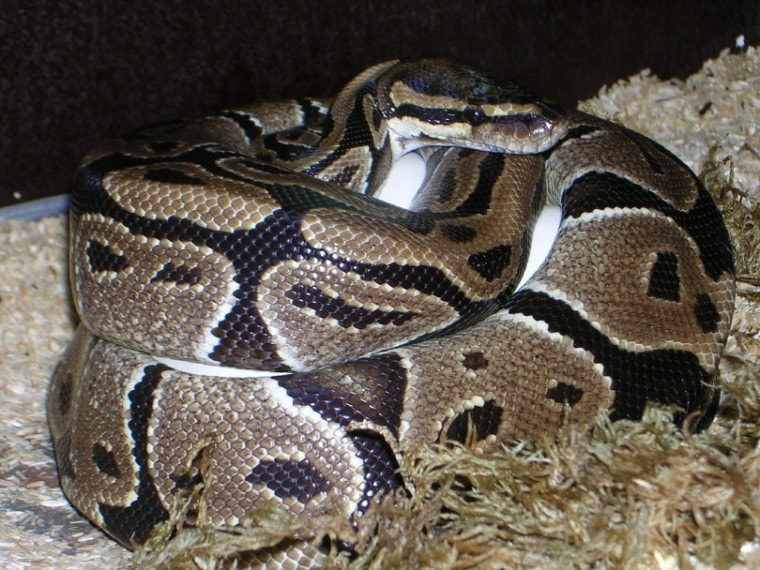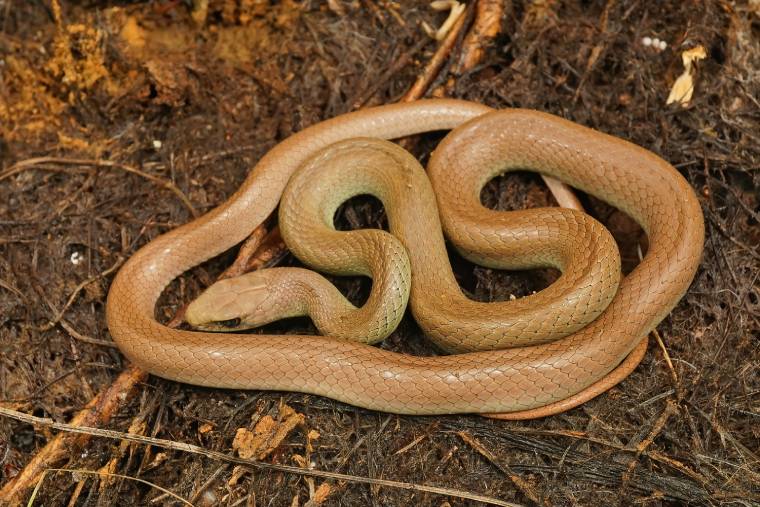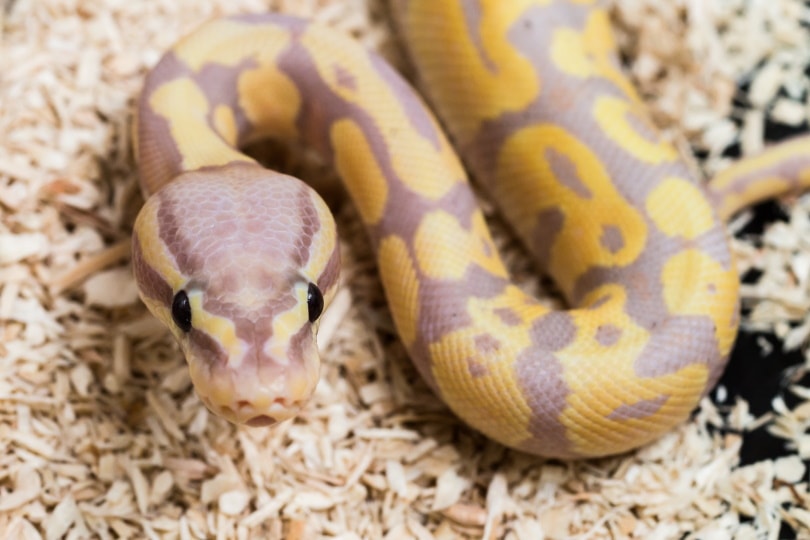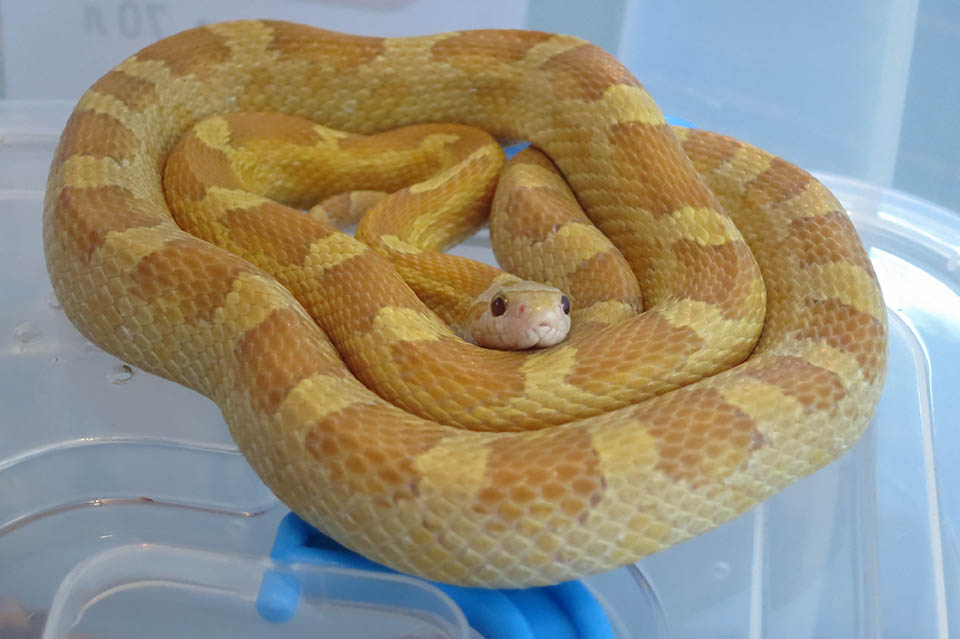
The Super Pastel ball python morph is a unique type of the pastel gene with extreme yellow coloration. The name is derived from the fact that they are extremely light in color and have a clear pattern. They’re typically accompanied by blushing, which makes them stand out even more!
In this article, we will explore everything you need to know about these beautiful snakes, including what they eat, how to care for them properly as pets, and their life expectancy!
Quick Facts about Super Pastel Ball Python Morphs
Species Name:
Ball Python
Common Name:
Python
Care Level:
Beginner
Lifespan:
20 – 25 years
Adult Size:
4 – 5 feet
Diet:
Small rodents
Minimum Tank Size:
40 gallons
Temperature & Humidity:
Temperature: 80°F – 90°F
Humidity: 50 – 60%
Do Super Pastel Ball Pythons Make Good Pets?

Most people think ball pythons are not good pets because they’re too aggressive or don’t tolerate handling well. This might be true of a wild snake, but one raised with love in captivity will be as cool as a cat!
The Super Pastel Ball Python is an excellent pet for beginners looking to experience the world of snake keeping. When properly socialized, they’re docile, not aggressive, and easy to care for! They are some of the most low-maintenance pets you can have because a majority of their time is spent in a self-regulating state.
Super Pastels are very shy by nature but will still greet you if given enough space. They also make great travel companions!
Appearance
The Super Pastel ball python is gorgeous. The striking yellows are complimented with a clean pattern. The blushing is also dramatic in these creatures, and it typically covers the entire upper half of their body.
Blushing on a snake refers to the red or pink coloration that occurs across the top of a snake’s body. The difference between a Super Pastel ball python and a pastel ball python is that a Super Pastel will typically have brighter yellows and more blushing than the latter.
How to Take Care of a Super Pastel Ball Python
Habitat, Tank Conditions & Setup
A happy ball python lives in the proper habitat. It would help if you tried to recreate their natural habitat as closely as possible when giving them a home.
Tank

The enclosure should be 30-40 gallons at the very least, with a screen lid to allow for airflow and mesh bottom panels so the snake can more easily regulate body temperature.
Be sure to provide plenty of branches for climbing and hiding spots, live plants, and a hide box. You should try to keep the tank livable by regularly cleaning it and keeping the water clean.
Lighting
To recreate the natural lighting conditions of the ball python, you should provide a high-quality UVB light. Provide the snake with natural sunlight to help them produce vitamin D, but the sunlight will not provide enough UVB necessary for their health.
The light cycle should be regular throughout your pet’s life. They should have direct lighting for about 12 hours a day, and they could have indirect light for their whole life.
Heating (Temperature & Humidity)
Ball pythons usually like to have a warm side and a cool side. You can provide this through heat lamps or lighting that mimics the sun, but be sure to offer someplace for them to cool off as well.
You can make basking spots out of anything from a ceramic heat emitter to an infrared heating bulb suspended on the ceiling. You’ll want to keep the temperature between 80-90 degrees, keeping the basking spot at the higher end of the spectrum. This is easiest done with a thermometer.
Humidity levels should be kept between 50-60%.
Substrate
The ideal substrate for a Super Pastel ball python mimics the environment they come from. Originally from sub-Saharan Africa, you can use African sand or soil with a high percentage of eco-earth.
To help your pet feel safe and secure, you could also add moss, bark, mulch, or a hollow coconut husk.
Tank Recommendations
| Tank Type: | 40-gallon glass vivarium |
| Lighting: | UVB Lighting |
| Heating: | Heating pad/tape on bottom of enclosure |
| Best Substrate: | Aspen bedding |
Feeding Your Super Pastel Ball Python

Like any other snake, a python can eat prey of various sizes, depending on how big they are themselves. As hatchlings, they may eat crickets, but you will start feeding them small rodents as they grow larger and stronger.
While most pythons grow big enough to eat rats, you’ll probably want to stick to small mice and feed your python once per week. Do not forget to feed your python their prey, or they may become aggressive.
Diet Summary
| Rodents: | 95% of diet |
| Small Birds/Lizards: | 5% of diet |
Keeping Your Super Pastel Ball Python Healthy
Ball pythons are relatively easy to care for, so long as you keep their habitat clean and monitor them often. However, it is essential that they have a healthy diet and you make sure they’re eating.
Vet visits are recommended every year, and when your ball python is feeding, you may take a stool sample.
If there are any abnormalities or if the pythons refuse to eat, take them to the vet right away.
Common Health Issues.
You’ll want to monitor their shedding, as pythons are prone to skin issues if kept in too humid of an environment. Additionally, while pythons are typically cold-blooded creatures, they may have a fever when ill or stressed.
You may also be able to monitor their health by paying attention to the patterning on the ball python’s skin for any abnormalities.
Lifespan
Ball pythons live 10-15 years in the wild. In captivity, with proper care and feeding, their lifespan is extended to 20-30 years. The oldest recorded python was 62 years old!
A python’s lifespan depends on many things, including how well they were cared for, and genetic predispositions.
Breeding
These types of snakes have long reproductive lives and the capacity to lay a lot of eggs! The female ball python will lay around six eggs at a time. Their mating season occurs from mid-September to mid-November.
Are Super Pastel Ball Pythons Friendly? Our Handling Advice

Holding a ball python is an exhilarating experience for first-timers and is generally safe.
When handling a ball python, make sure to keep it on a secure surface and try not to place your hand or fingers under the snake. Don’t make any sudden movements that can startle it.
The ball python has a “natural curve” in its spine that allows them to stretch out and coil up quickly, making handling much easier for beginners! You’re also not supposed to hold the snake if you have open wounds on your hands or skin.
Shedding & Brumation: What to Expect
The ball python sheds its outer layer approximately once per year on average.
During the shedding period, you’ll notice a reddish tint in their eyes and around the mouth. This is normal; they are not sick or dying! The snake will also start to feel soft—this means that it’s time for them to shed its outer layer of skin and reveal new layers underneath. If this process doesn’t happen naturally, you can help the snake shed by lightly rubbing your hands over its body.
Brumation is a natural process that allows the snake to slow down and rest for winter. It’s not necessary to hibernate them in their enclosure unless it’s too warm where they live year-round. If this is the case, then we recommend that you look into hibernation.
How Much Do Super Pastel Ball Pythons Cost?
The cost of adoption will vary greatly depending on where the snake is located and the breeder. On average, you can expect to pay between $40-60 for your snake. However, these aren’t the only costs to keep in mind.
You will need to spend money on the enclosure, cleaning, substrate, and a heat lamp. You may also need other accessories, including food dishes, a water dish, or bowls for soaking in warm water during the shedding process, something that can be used as an egg raft if you are breeding them, etc.
These things add up to about $200 minimum to properly care for your snake. After that, ongoing costs include food, cleaning supplies, and the occasional visit to the vet.
Care Guide Summary
Final Thoughts
The Super Pastel ball python morph is a snake that has taken the pet world by storm. They are one of the most popular and beautiful breeds in the exotic animal community. Still, their easy-care requirements and friendliness make them so desirable for beginners or experienced herpetologists alike.
If you’re looking for a snake that’s docile and flamboyant, this might be the one for you!
Featured Image Credit: Soundfrau, Pixabay










